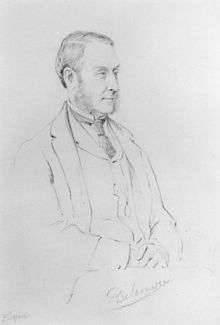Hugh Cholmondeley, 2nd Baron Delamere
Hugh Cholmondeley, 2nd Baron Delamere (/ˈtʃʌmli/; 3 October 1811 – 1 August 1887), styled The Honourable from 1821 until 1855, was a British peer and politician.[1]
The Lord Delamere | |
|---|---|
 Pencil drawing of Hugh Cholmondeley, 2nd Baron Delamere, by Frederick Sargent, circa 1860s or 1870s | |
| Born | 3 October 1811 Vale Royal, Cheshire, England |
| Died | 1 August 1887 (aged 75) Vale Royal, Cheshire, England |
| Nationality | British |
| Education | Eton College |
| Occupation | Politician |
| Spouse(s) | Lady Sarah Hay-Drummond
( m. 1848; died 1859)Augusta Seymour ( m. 1860) |
| Children |
|
| Parent(s) |
|
Personal
Hugh Cholmondeley was the eldest son of Thomas Cholmondeley. His mother was Henrietta Elizabeth Williams-Wynn,[1] daughter of Sir Watkin Williams-Wynn, 4th Baronet, and Charlotte Grenville, and a granddaughter of Prime Minister George Grenville. Lord Delamere was an indirect descendant of Sir Robert Walpole, the first Prime Minister of Great Britain.[2]
In 1848, Cholmondeley married Lady Sarah Hay-Drummond, daughter of Thomas Hay-Drummond, 11th Earl of Kinnoull; and the couple were childless when she died in 1859. He married again in 1860, this time to Augusta Emily Seymour, daughter of Sir George Hamilton Seymour.[1] The children of that marriage were:
- Hugh Cholmondeley, 3rd Baron Delamere (28 April 1870 – 13 November 1931);[1] married, firstly, Lady Florence Cole, daughter of Lowry Cole, 4th Earl of Enniskillen, and Charlotte Baird, in 1899; had issue. He married, secondly, in 1928, Gwladys Beckett, who later became the second female Mayor of Nairobi.
- Hon. Sybil Cholmondeley (29 December 1871 – 26 May 1911);[3] married Algernon Edwyn Burnaby and had issue.
Lady Delamere died in 1911. She had survived her husband for 24 years.[1]
Career
Cholmondeley was elected to Parliament for Denbighshire as a Tory in 1840, a seat he held until 1841, and then represented Montgomery from 1841 to 1847. In 1855, Cholmondeley was called to the House of Lords when he succeeded his father as second Baron Delamere.[4]
Lands and estates
In this period, Baron Delamere and his family were inextricable from the history of Cheshire and married into the Hibbert Family of Birtles Hall,Cheshire who had made their fortune in Jamaica. The family seat was at Vale Royal Abbey.[5]
Baron Delamere died at age 75 in August 1887; and he was succeeded in the lands, estates and title by the son from his second marriage, Hugh Cholmondeley.[1]
Notes
- Lundy, Darryl. "2nd Baron Delamere, ID #29419". The Peerage.
- Hayden, Joseph. (1851). The book of dignities, pp. 527, 565.
- "Mrs. Burnaby Dies; Lord Delamere's Sister Fell from a Third Story Window of Her House," New York Times. 27 May 1911.
- Lundy, Darryl. "1st Baron Delamere, ID #29417". The Peerage.
- Holland, G.D et al. (1977). Vale Royal Abbey and House, pp. 20-32; Westair-Reproductions: Cheshire, Museum finder
References
- Debrett, John, Charles Kidd, David Williamson. (1990). Debrett's Peerage and Baronetage. New York: Macmillan. ISBN 978-0-333-38847-1
- Holland, G.D et al. (1977). Vale Royal Abbey and House. Winsford, Cheshire: Winsford Local History Society. OCLC 27001031
- Hayden, Joseph. (1851). The book of dignities: containing rolls of the official personages of the British Empire. London: Longmans, Brown, Green, and Longmans. OCLC 2359133
External links
- Hansard 1803–2005: contributions in Parliament by Hugh Cholmondeley
- National Portrait Gallery, London: NPG 5639 (pencil drawing), Hugh Cholmondeley, 2nd Baron Delamere by Frederick Sargent (c. 1860s-1870s).
| Parliament of the United Kingdom | ||
|---|---|---|
| Preceded by Sir Watkin Williams-Wynn, 5th Bt William Bagot |
Member of Parliament for Denbighshire 1840–1841 With: William Bagot |
Succeeded by William Bagot Sir Watkin Williams-Wynn, 6th Bt |
| Preceded by John Edwards |
Member of Parliament for Montgomery 1841–1847 |
Succeeded by David Pugh |
| Peerage of the United Kingdom | ||
| Preceded by Thomas Cholmondeley |
Baron Delamere 1855–1887 |
Succeeded by Hugh Cholmondeley |